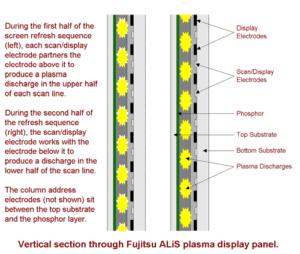Developed by Fujitsu as an improvement to the Three Electrode Surface Discharge method of driving a PDP, which it invented in 1984, ALiS (Alternate Lighting of Surfaces) displays are not made up of enclosed pixel elements with the display electrodes fixed to both top and bottom substrates, as are conventional side discharge PDPs.
Instead, the two substrates are separated only by spacer columns with the main display electrodes mounted on the same substrate with only the column address electrodes (also acting as pre-charge electrodes) mounted on the opposite substrate. This arrangement of electrodes makes it possible to control the top and bottom portions of each pixel element independently during alternate vertical refreshes, two scan lines being controlled using just three electrodes (see diagram). Using this technique, the vertical resolution of the panel is effectively doubled, making it suitable for displaying HDTV pictures of 1,000 or more lines.
Fujitsu says that, apart from the obvious advantage of increased vertical resolution using the same number of electrodes, ALiS displays are brighter, more reliable and have a longer life than “conventional” PDPs. They can also display interlaced TV signals without requiring scan conversion circuitry as they themselves use an interleaved addressing system.
Update: Fujitsu joined its PDP making division with Hitachi and then Hitachi took over the whole PDP operation. Hitachi’s PDP operation still uses the ALiS concept as at July 2006.

